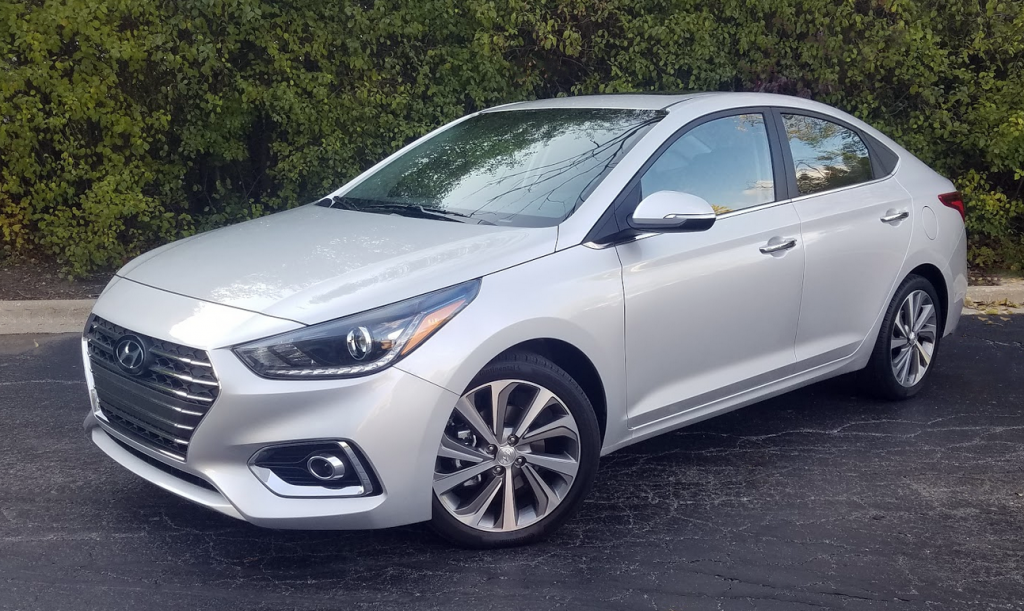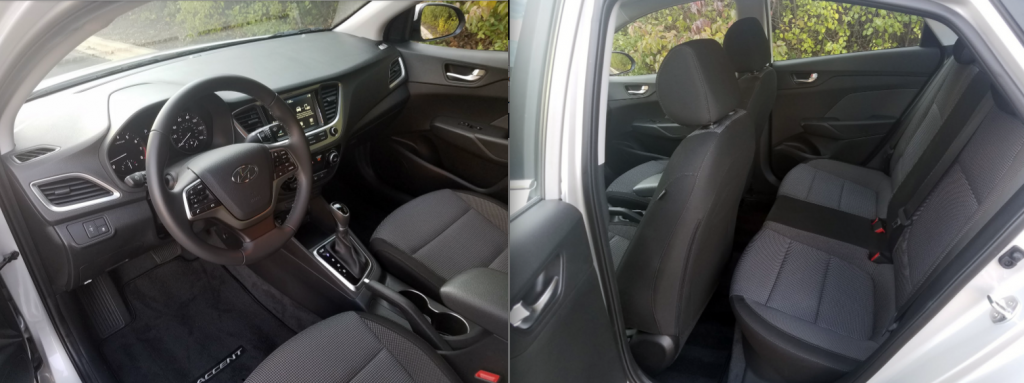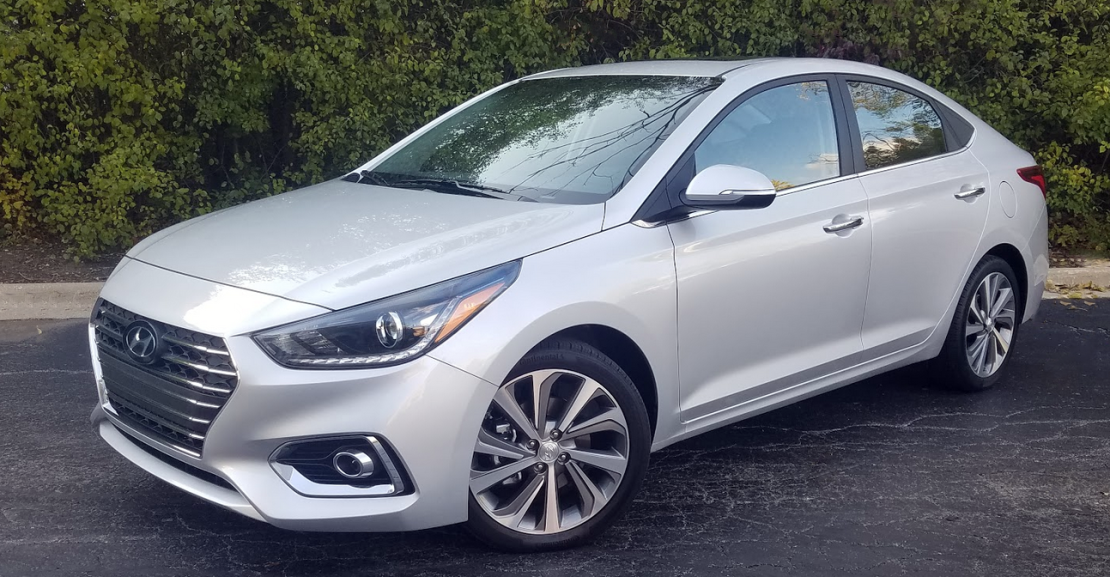

The subcompact-car market isn’t anywhere near as hot as the subcompact-SUV category these days, but there is still activity afoot. The segment’s biggest news for 2018 is the introduction of two redesigned contenders from South Korea—the Kia Rio and the Hyundai Accent. Both of these vehicles are built on the same basic platform; we’ll be driving the new Rio in the near future, and we just got our first taste of the new Accent.
The 2018 Accent is about a half-inch longer in wheelbase and overall length, and a little more than an inch wider than the vehicle it replaces. A “cascading” grille design (a look Hyundai says is inspired by the shape of molten steel being poured) connects the Accent’s styling with the rest of the Hyundai lineup. Hyundai endeavored to keep the Accent’s model roster as simple as possible. The lineup ascends through SE, SEL, and Limited models, and there are no option packages or stand-alone options save for accessory items such as floor mats and the like. A four-door sedan is now the only body style; there is no longer a hatchback model. (The previous-generation’s four-door hatchback accounted for only 15 to 20 percent of total Accent sales.)
Test Drive: 2018 Honda Fit EX-L

Standard features on the base SE model include 60/40 split folding rear seats, Bluetooth connectivity, 5-inch color touchscreen, rearview camera with dynamic guidelines, and steering wheel audio and cruise controls. The midline SEL model gets an upgraded infotainment system with a 7-inch touchscreen and Apple CarPlay/Android Auto functionality, dual USB ports, automatic headlamps, and 15-inch alloy wheels with 4-wheel disc brakes (the SE has rear drum brakes and steel 15-inch wheels with wheelcovers).

The line-topping Limited adds a number of features, including a forward collision-warning system with automatic emergency braking, 17-inch alloy wheels, power sunroof, keyless entry and starting, LED daytime running lights, LED taillights, and Hyundai’s Blue Link Connected Services (a suite of various smartphone-controlled remote-access functions and connectivity features). Inside are heated front seats, leather-wrapped steering wheel and shift knob, automatic climate control, and a 3.5-inch TFT (thin-film transistor) instrument-panel display. Also included is Hyundai’s hands-free smart trunk, which opens automatically when you stand at the back of the locked vehicle for about three seconds with the key fob on your person.
Test Drive: 2018 Toyota C-HR XLE

The sole engine available on all models is a 1.6-liter direct-injection 4-cylinder that puts out 130 horsepower and is EPA-rated at 28 mpg city/38 highway/32 combined with the standard 6-speed automatic transmission and 28/37/31 with the 6-speed manual transmission (which is available only on the base SE trim level).
Our drive time in the Accent was brief—we got to spend about a half hour in a Limited model—but it was enough for us to form some initial impressions. We’ll have a more in-depth test drive in the near future, when we have an Accent through our office test fleet.
True to Hyundai form, the Accent’s instrument panel has a clean, straightforward layout that is very user friendly; it has clear gauge markings and large, easy-to-use buttons, knobs, and touchscreen icons. And, true to the budget-conscious subcompact-car class, there is plenty of budget-grade hard plastic in the interior; outside of the seats, the center armrest is about the only padded surface. The seat padding is a bit on the spongy side, but the cloth upholstery looks and feels decent for the price point. Leather upholstery isn’t available, but the Limited’s leather-wrapped steering wheel and shift knob help class things up a bit. Headroom and legroom in the front seats are adequate even for plus-size adults—your tester is 6’6” and he fit comfortably enough. Rear-seat room is expectedly tight, but it’s on par with most class competitors.
As subcompacts go, the new Accent is laudably quiet overall—credit the new body structure and some improved body insulation/door-sealing measures. Wind and road noise are pretty well controlled; the engine is fairly quiet at cruise, but still gets a bit noisy in fast acceleration—or at least what passes for fast acceleration in a subcompact. The Accent’s 130-hp rating is one of the best in its class, but most subcompact cars aren’t what you’d call quick. The Accent’s engine needs to build up rpm before decent acceleration arrives, and has to strain a bit to provide adequate go for passing maneuvers or entering an expressway.

A Sport drive-mode setting alters powertrain performance and steering for a more athletic feel, but we doubt most drivers will use it much. In Sport mode, the transmission holds gears longer for quicker acceleration, which can make the car feel unpleasantly high-strung if you’re not driving in an aggressive fashion.
Ride and handling are well sorted. There is a bit of “clunkiness,” both in noise and feel, from the suspension when going over sharp bumps, but the ride is reasonably pleasant otherwise. Limited models come standard with 17-inch wheels; the 15s in SE and SELs are likely a tad more absorbent overall. The steering feel is excellent for a subcompact; it’s nicely weighted and responsive, if not particularly communicative. And, the Accent’s tidy exterior dimensions make it very easy to maneuver and park.
Pricing for the 2018 Accent has not yet been released, but Hyundai will likely aim to stay close to the outgoing-generation Accent’s pricing, which started at $14,745 for a manual-transmission SE and ran to $17,495 for the topline model. Pricing for the similar 2018 Kia Rio starts at $13,900 and tops out at $18,400. If the Accent’s MSRPs stay in that ballpark, Hyundai’s new penny-pinching sedan will strike us as a fine value for the money.



